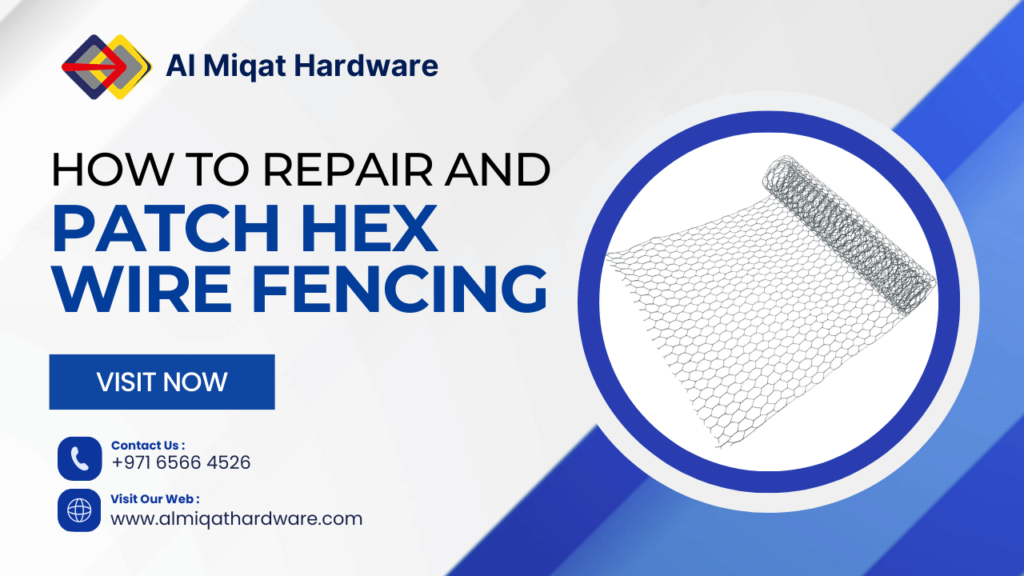Hex wire fencing—also known as chicken wire or hexagonal wire mesh—is a popular choice for many agricultural, residential, and industrial applications. It’s affordable, flexible, and effective for everything from keeping animals in (or out) to supporting plants and securing boundaries.
However, over time, even the most durable hex wire fencing can suffer from wear and tear. Whether it’s due to weather, rust, animals, or accidental impact, holes and damage can compromise the fence’s effectiveness.
At AL Miqat Hardware, we supply high-quality hex wire mesh that’s built to last. But if your existing fence has seen better days, you don’t always need to replace the whole thing. With the right tools and a bit of effort, you can repair and patch hex wire fencing on your own.
In this blog, we’ll walk you through why fences get damaged, the materials you’ll need, and step-by-step instructions to patch and strengthen your hex wire fencing.
Common Causes of Hex Wire Fence Damage
Understanding what causes damage to your hex wire fence can help prevent future issues. Here are the most frequent culprits:
- Rust and Corrosion: Especially common in humid or coastal environments.
- Animal Activity: Dogs, goats, chickens, or even wildlife like foxes and raccoons can chew or push through weak spots.
- Impact Damage: Falling tree branches, farming equipment, or vehicles can tear or dent the wire.
- Weather Exposure: Strong winds or heavy rainfall can loosen the mesh or cause sagging.
- Aging: Over time, the material can weaken, especially if it wasn’t UV-treated or galvanized.
Tools and Materials You’ll Need
Before you start repairing, gather the following tools and supplies:
🔧 Tools:
- Wire cutters or fencing pliers
- Gloves (to protect from sharp wire ends)
- Safety glasses (recommended)
- Hammer or staple gun (for wooden frames)
- Zip ties or fencing clips (optional)
🧰 Materials:
- Replacement hex wire mesh (galvanized or PVC-coated)
- Binding wire or steel tie wire
- U-nails or fencing staples (for wood posts)
- Extra fence posts or supports (if needed)
You can find all these materials at AL Miqat Hardware, where we offer both bulk and custom-sized wire mesh rolls suitable for repairs or replacements.
Step-by-Step Guide to Repairing Hex Wire Fencing
Step 1: Inspect the Damage
Start by walking along the fence line and identifying all holes, sagging areas, rust spots, and broken ties. It’s best to repair all issues in one go to save time later.
💡 Tip: Mark damaged sections with colored tape or chalk so you can find them easily during the repair.
Step 2: Cut Out the Damaged Section
Use wire cutters or fencing pliers to carefully remove the damaged portion of the mesh. Be sure to cut at least 2–3 hexes wider than the damaged area to give your patch plenty of overlap.
⚠️ Safety First: Wear gloves to avoid cuts from sharp wire ends.
Step 3: Prepare the Patch
Cut a replacement piece of hex wire mesh that’s slightly larger than the hole. This allows for overlapping, which helps secure the patch more firmly to the existing fence.
If the fence is old and rusty, consider using a PVC-coated mesh for better long-term durability.
Step 4: Attach the Patch
Align the patch over the damaged area. Use binding wire, fencing clips, or zip ties to secure the new mesh to the old one. Twist the wires tightly around the mesh intersections to keep it from shifting.
For wooden frames, use fencing staples or a staple gun to attach the patch securely to posts or rails.
💡 Pro Tip: Twist the cut ends inward or flatten them to avoid injuries and give a neater finish.
Step 5: Reinforce Weak Areas
While you’re repairing, it’s a good idea to check nearby sections for rust, sagging, or loose connections. Add extra wire ties or install additional fence posts to reinforce any weak spots.
If sagging is a problem, install a tension wire along the top or bottom of the fence and attach the mesh to it for added support.
Apply Rust Protection
If your fence is not already galvanized or PVC-coated, consider spraying the repaired area with anti-rust spray or paint to protect against future corrosion. This small step can extend the life of your repair significantly—especially in humid or salty environments like the UAE or coastal regions.
When to Replace Instead of Repair
While patching works for minor to moderate damage, sometimes the fence is beyond repair. You might consider full replacement if:
- Over 30% of the fence is damaged
- The wire is brittle and breaks easily
- Posts are rotting or leaning badly
- Rust has spread across large areas
In such cases, it’s more cost-effective and secure to install a new fence using high-quality hex mesh from AL Miqat Hardware.
Conclusion
Repairing hex wire fencing may seem like a small job, but it can make a big difference in maintaining the safety and function of your property. With just a few tools, some spare mesh, and a bit of effort, you can restore your fence and extend its life for years to come.
At AL Miqat Hardware, we offer a wide selection of hexagonal wire mesh in various coatings, sizes, and gauges—perfect for everything from small repairs to full installations. Our team is always ready to help you find the right materials and guide you on best practices for fence repair and maintenance.


